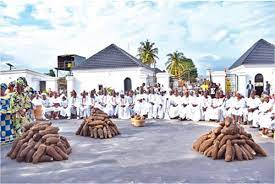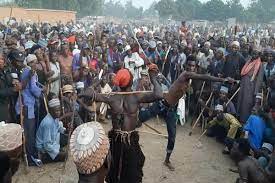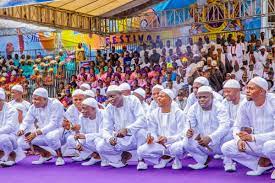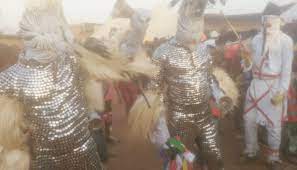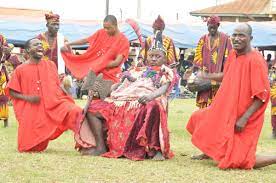
The Sango Festival is an annual celebration that has been observed for centuries in Nigeria. It is a time for people to come together and honor the Yoruba deity Sango, who is the god of thunder and lightning. As well as being a religious holiday, the Sango Festival has immense cultural significance, and has evolved to include traditional music, dancing, and food.
In this blog post, we will explore the history of the festival, its various traditions, and the impact it has had on Nigerian culture and society.
What is the Sango Festival?
The Sango Festival is a traditional cultural celebration that takes place in Nigeria. It is dedicated to the worship and reverence of Sango, the Yoruba god of thunder and lightning. This annual festival is a time for the community to come together and honor this powerful deity, seeking his blessings and protection.
During the Sango Festival, devotees dress in traditional attire and participate in various rituals and ceremonies. These rituals include dancing, drumming, and chanting, all in praise of Sango. Offerings such as food, drinks, and sacrifices are made to the deity, symbolizing gratitude and seeking his favor.
The festival also features vibrant parades, showcasing the rich cultural heritage of the Yoruba people. Colorful floats and costumes add to the lively atmosphere, creating a visual spectacle for both locals and visitors alike.
The Sango Festival holds deep significance in Nigerian culture, as it reinforces the importance of unity and spiritual connection. It serves as a reminder of the Yoruba traditions and beliefs, keeping them alive for future generations. Through this celebration, the Yoruba people honor their ancestors and express their devotion to Sango.
In recent years, the Sango Festival has evolved to include modern elements, such as music concerts, art exhibitions, and fashion shows. This adaptation has helped to attract a wider audience and promote cultural tourism in Nigeria. However, at its core, the Sango Festival remains a sacred and cherished event that continues to be a pillar of Yoruba culture.
The Origins of the Sango Festival
The Sango Festival is a cultural celebration that holds deep historical and spiritual significance in Nigerian culture. The festival is named after Sango, a legendary deity who was revered as the god of thunder and lightning in Yoruba mythology. According to ancient Yoruba beliefs, Sango was a powerful and charismatic ruler who possessed extraordinary powers.
The origins of the Sango Festival can be traced back to the ancient city of Oyo, which was once the capital of the powerful Oyo Empire. It is believed that the festival was established as a way to honor and pay homage to Sango, who was considered to be a protector of the Yoruba people. The festival initially began as a religious ceremony to ensure fertility, protection, and good fortune for the community.
During the festival, elaborate rituals and ceremonies are performed to invoke the spirit of Sango. These rituals include drumming, dancing, and chanting by traditional worshippers known as "Egungun" in colorful costumes. Participants also make offerings of food, fruits, and palm wine to the deity as a gesture of reverence.
Over the years, the Sango Festival has evolved and become more than just a religious event. It has transformed into a major cultural celebration, drawing both locals and tourists from far and wide. The festival provides an opportunity for the community to come together, celebrate their heritage, and showcase their rich cultural traditions.
The Sango Festival is not only a time for revelry and joy but also a time to connect with Nigerian history and traditions. It serves as a reminder of the importance of cultural preservation and the resilience of the Nigerian people.
Traditional Rituals and Customs
The Sango Festival is rich in traditional rituals and customs that have been passed down through generations. These practices are deeply rooted in Yoruba culture and are integral to the overall celebration of the festival.
One of the main rituals observed during the Sango Festival is the pouring of libations. This involves offering prayers and offerings to Sango, the Yoruba god of thunder and lightning. Participants pour palm wine onto the ground or onto a symbolic representation of Sango while reciting prayers and invoking blessings. This act is believed to please the deity and bring prosperity and good fortune to the community.
Another significant custom is the wearing of traditional Sango attire. Participants don vibrant red and white garments, symbolizing the colors associated with Sango. They also adorn themselves with accessories such as beads, cowrie shells, and feathers, representing the deity's attributes and powers.
Furthermore, traditional drumming and dancing play a crucial role in the Sango Festival. Skilled drummers provide rhythmic beats, while dancers, often possessed by the spirit of Sango, showcase their agility and strength. The dances are highly energetic, symbolizing the power and vibrancy of Sango.
These rituals and customs not only provide a deeper understanding of Sango's significance in Yoruba culture but also serve as a means of connecting with ancestral traditions and promoting unity within the community. By participating in these age-old practices, individuals are able to preserve their cultural heritage and pass it on to future generations.
Festivities and Celebrations
The Sango Festival is marked by vibrant and energetic festivities that showcase the rich cultural heritage of the Yoruba people. The celebrations begin with a colorful procession, where participants don traditional attire and parade through the streets, singing and dancing to rhythmic beats of traditional drums.
One of the highlights of the festival is the performance of the “Epa” masquerades. These larger-than-life characters, adorned in elaborate costumes and masks, represent the deities and spirits associated with Sango. They entertain the crowd with their energetic and acrobatic movements, bringing joy and awe to all who witness them.
During the festival, various cultural activities take place, such as traditional dances, musical performances, and storytelling sessions. People gather around bonfires to listen to ancient myths and legends, keeping the Yoruba traditions alive. There are also stalls selling traditional crafts, artwork, and delicious local delicacies.
A significant aspect of the festivities is the reenactment of Sango's legendary battles and victories. Warriors dress in ancient battle attire, engaging in mock battles with swords and spears. This reenactment symbolizes the triumph of good over evil and serves as a reminder of the bravery and strength of Sango, the Yoruba god of thunder and lightning.
The celebrations culminate in a grand feast, where the community comes together to enjoy a delicious meal prepared with traditional ingredients and recipes. This feast is a time of unity and gratitude, as people gather to appreciate their culture and express their devotion to Sango.
The festivities and celebrations of the Sango Festival are not only a time of joy and merriment but also a powerful means of preserving and honoring the Yoruba cultural heritage for future generations.
Significance and Importance in Nigerian Culture
The Sango Festival holds immense significance and importance in Nigerian culture. This festival is dedicated to Sango, the Yoruba deity of thunder and lightning. In Yoruba mythology, Sango is a powerful and influential god who represents the elements of fire and courage. As such, the Sango Festival serves as a way for the Yoruba people to honor and pay homage to this deity.
This festival holds deep cultural and historical roots in Nigeria. It is celebrated annually and is a time for communities to come together in joyous celebration. The festival involves various rituals and ceremonies, including processions, music, dancing, and sacrifices. The sacrifices made during the festival are believed to bring blessings and protection from Sango.
The Sango Festival is not only a religious celebration but also a way to preserve and promote Nigerian heritage and culture. It provides an opportunity for Nigerians, both at home and abroad, to connect with their roots and learn more about their traditions. The festival showcases traditional music, dance, and attire, allowing the younger generations to gain a deeper understanding and appreciation for their cultural heritage.
Additionally, the Sango Festival serves as a platform for community bonding and unity. It brings people together, fostering a sense of belonging and pride in their shared identity. It serves as a reminder of the rich history and diverse cultural tapestry that makes up Nigeria.
Overall, the Sango Festival is of great significance and importance in Nigerian culture. It not only honors a powerful deity but also acts as a catalyst for preserving, promoting, and celebrating Nigerian traditions, values, and identity.
Modern Adaptations and Evolution of the Festival
The Sango Festival has seen several modern adaptations and evolutions throughout the years, keeping the tradition alive while also embracing contemporary elements. One notable modern adaptation is the incorporation of technology into the festival. In recent years, social media platforms have played a significant role in promoting and documenting the festival. People from all over the world can now witness the vibrant colors, energetic performances, and intricate costumes through live streams and videos shared online.
Additionally, the festival has become a major tourist attraction, drawing both local and international visitors. This has led to the development of infrastructure and facilities around the festival grounds, such as hotels, restaurants, and souvenir shops, to accommodate the growing number of tourists.
Furthermore, the Sango Festival has also evolved to address contemporary social issues. In recent years, the festival has become a platform for advocating for gender equality and women's empowerment. Women are now encouraged to participate actively in the festival, taking on leadership roles and showcasing their talents.
The modern adaptations and evolution of the Sango Festival have not only helped preserve the cultural heritage but have also ensured its continued relevance and growth. By embracing technology, attracting tourists, and addressing social issues, the festival continues to thrive and adapt to the changing times while maintaining its cultural significance.

















